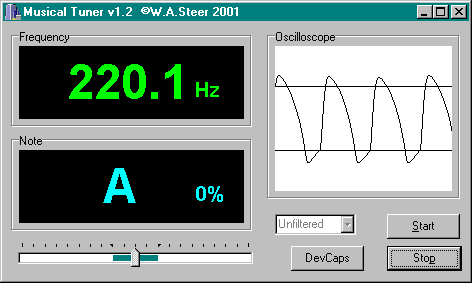"Perfect pitch will not help you find your starting note in the absence of sound" - Coalport
Thanks for clearing that up, Peter! I was under the belief that "perfect pitch" was absolute - As in, someone with perfect pitch would be able to hum a perfect A440 when asked to.... Thinking about it now, thats such an absurd idea I wonder how I didnt see it for the baloney it was ;-)
So .. Perfect pitch and perfect reletive pitch are one and the same.. If you hear a note, are told its a "C" one can hum the C Major scale (provided you know its sequence) based on the given note... In fact, you dont need to know its a "C" - You can start at any note, even if not "on key" and produce any scale or tune or whatever reletive to that..
And if you can do the above, and your reletive notes are spot-on when you hum or play a theremin or other instrument without visual or tactile feedback, you have "perfect pitch" (!?)
Hey, that makes me feel a lot better ;-) .. And a bit less like I am missing out on some rare ability only a few lucky people posess.. LOL ;-)
Fred.
Re visual feedback... Humming or singing or whisteling etc (your voice) must surely be classed as an instrument without any visual feedback - even less feedback than the theremin! - but those with a good sense of pitch can do this without any need for visual guidance... Sure, the voice is probably the easiest instrument to control, the one we have the most intimate connection with, and it gives me sensory feedback which is a kind of "preview" - one knows by the tension on the vocal chords exactly what tone will come out before you make a sound (I find this less true when trying to whistle)
Which kind of re-inforces Thierry's comments me thinks - I had wondered whether his arguments regarding trombone, violin, odes was as valid as it first appeared, thinking that perhaps the not-obvious-but-perhaps-still-present visual feedback was important.. But thinking about the voice, I think he is completely correct.
One needs to "know" what the correct pitch should sound like in order to produce it.. And if you know it, but cannot produce it, the problem is with the control mechanism or the sensory feedback... And with audio preview from the theremin, you have this feedback - so if you still cannot get the note, the problem is with the control mechanism...
But it is only if you dont know the pitch you need to play (you cannot hear it in your head, or tune your vocal chords to it) only then, I think, could visual guidance be useful - "The display shows that I am at C and the next note I need to play is G, so I need to go closer" - And I think most people who play the theremin have gone beyond that level in a few weeks... Or else they just dont have what is needed to play this instrument melodically and certainly dont have what is required for precision playing...
The only practical reason for pitch display that I can see is therefore if, for whatever reason, one refuses to have audio preview - Then visual feedback MIGHT help to avoid fishing for the correct note when bringing the volume up from silence.. In this regard, I think the visual feedback from the trombone/violin/odes and the sensory feedback from the voice may be an advantage, and some form of visual 'cuing' added to the theremin mignt help.
I think that those who "dont have what is needed to play this instrument melodically and certainly dont have what is required for precision playing" can still have fun with it and use it musically or creatively - Some of the most interesting theremin music I listen to (and it is music!) doesnt have any pretention about trying to comply with musical scales or "normality".. And I doubt if these musicians would have any interest in visual pitch display... And I have no idea if they can hear their "target" pitch in their head before they play it, or if their music is controlled by other forces ;-) .. All I know is that I enjoy listening to it (in small doses ;-)



